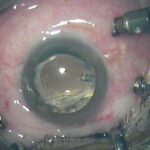Sitting in the ophthalmologist’s waiting room, I glanced at the images posted on the wall of what it might look like, seeing through the eyes of someone with various types of eye diseases. Macular degeneration appeared as the label on one picture. At a recent eye exam, my optometrist told me I had dry macular degeneration. The thought that I might eventually lose part of my vision sent me to an ophthalmologist for a second opinion. I have worn glasses since second grade. I am extremely nearsighted, see floaters in both eyes, and see occasional flashes of light peripherally from my left eye. The latter condition, seeing flashing lights, I was told could lead to a detached retina and subsequent blindness. Now, dry macular degeneration has been added to my calamity of eyesight issues.
My eye problems, symptoms of dry macular degeneration
At the eye exam with my optometrist, I mentioned that sometimes, the vision in my left eye is a little blurry, like looking through an oily film. When he asked if my ability to read had changed, I said it had not though I find I can read better if I place a lamp closer to my reading material. Those two revelations, blurry vision and needing more light to read, triggered an investigation into the potential of macular degeneration. This eye disease affects vision in the central part of the retina where tissues starts wasting away. The result is blurry vision or darkness but only in the center of the eye. Peripheral vision is not affected. “Age-related” (as in the 55+ age range) may appear before macular degeneration, drawing an acronym of AMD.
Diagnosing dry macular degeneration
After dilating my pupils with eye drops, the eye doctor used a magnifying prism to exam the back of my eyes. It was there that drusen was observed. Drusen is a yellow deposit in the macular of the eye. The size and quantity of drusen contribute to identifying the stage of macular degeneration: early, intermediate or advanced. The ophthalmologist agreed with the optometrist. I have macular degeneration. I am at the intermediate stage of this eye disease.
My future with dry macular degeneration
I was told that there is no way of telling how fast my vision will determinate but lifestyle changes may slow the progression. I was provided a listing of vitamins (like vitamin C) and minerals (like zinc and copper) with recommended dosage to include in my dietary supplements to help slow or even stop the progression of the disease. Along with the list of supplements, I was given the Amsler grid. Looking like graph paper with a dot in the center, I was told to cover one eye and look at the dot in the center of the grid.
The objective of viewing the Amsler grid is to determine if the lines on the grid appear distorted or blurry. I was directed to repeat this test on both eyes daily. Though there is only an issue with my left eye now, there’s a potential my right eye could also be affected by macular degeneration. My question to the doctor was, “So what do I do if I see distorted lines on the grid?” For reassurance, he said my eyesight may never worsen but if I did see the distorted lines on the grid, I should make an appointment to see him. Something tells me, since macular degeneration is not curable based on current medical knowledge, that the only thing he could do is pronounce me legally blind in the ailing eye.
Source: “Dry macular degeneration,” Mayo Clinic


